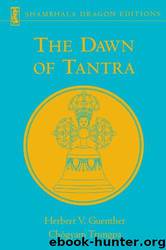The Dawn of Tantra by Herbert V. Guenther & Chogyam Trungpa

Author:Herbert V. Guenther & Chogyam Trungpa
Language: eng
Format: azw3, epub
Tags: Religion, Buddhism, General
ISBN: 9781570628962
Publisher: Shambhala
Published: 2001-11-13T00:00:00+00:00
NINE
Empowerment and Initiations
I WOULD LIKE TO speak about the initiations or abhishekas, to put them in proper perspective in terms of how they apply, when they come, and what is meant by them. In order to understand this intricate pattern, we must have a picture of the whole gradual process of spiritual development in Buddhism.
The situation in which spiritual development takes place is represented visually in the tantrayana as a mandala. A mandala is understood as a center which is beautiful because of its surroundings which are present with it. It represents a whole situation in graphic form. There is the center which stands for the teacher, or more esoterically, for the guru. The guru is never alone, but exists in relation to his surroundings. The surroundings are seen as the expression of a new orientation in relation to this center. The mandala is set up in terms of the four cardinal points of the compass. These points symbolize an orientation in which all aspects (directions) of the situation are seen in relation to the guru and therefore have their message. The whole situation becomes, then, a communication on the part of the guru or teacher. It depends on our level of spiritual growth whether we see the guru only concretely as a person or can also see him symbolically.
The mandala has a certain specific quality in that each situation is unique and cannot be repeated. Only similarities can obtain. The mandala also has its own time factor which cannot be equated with the passage of time as we ordinarily understand it. It has a quality of simultaneity of all aspects which goes beyond our ordinary understanding of sequence. If properly understood, the mandala leads us back to seeing what the spiritual path is, back to the possibility of becoming more related to our own being without identifying it with this or that. Even the understanding embodied in the mandala is traditionally surrendered and offered up as a guard against reification.
The Buddhist path, which leads to seeing one’s situation as a mandala, begins with taking refuge. We take refuge in the three jewels—the Buddha, the dharma, the sangha. This can happen on various levels. There is the ordinary physical level of just repeating the formula. But this also involves a process happening within us. Regarding this inner level, we have the instruction to take refuge in something which is abiding, something which can actually offer refuge. We can only take refuge in something certain; otherwise taking refuge would be a pure fiction and would not provide the security we want. So, on the inner level, taking refuge means surrendering to those forces of which we ourselves are, so to speak, the last transformation. These forces have, in a way, become frozen in us. Taking refuge thus means to commit ourselves to a process of unfreezing, so that life’s energy, or whatever we want to call these forces that operate through us and somehow get blocked, can flow freely.
Beyond this, taking
Download
The Dawn of Tantra by Herbert V. Guenther & Chogyam Trungpa.epub
This site does not store any files on its server. We only index and link to content provided by other sites. Please contact the content providers to delete copyright contents if any and email us, we'll remove relevant links or contents immediately.
The Way of Zen by Alan W. Watts(6292)
Ego Is the Enemy by Ryan Holiday(4963)
The Art of Happiness by The Dalai Lama(3851)
The Book of Joy by Dalai Lama(3704)
Why Buddhism is True by Robert Wright(3290)
Spark Joy by Marie Kondo(3089)
Shift into Freedom by Loch Kelly(3031)
Happiness by Matthieu Ricard(2888)
A Monk's Guide to a Clean House and Mind by Shoukei Matsumoto(2786)
The Lost Art of Good Conversation by Sakyong Mipham(2443)
The Meaning of the Library by unknow(2390)
The Third Eye by T. Lobsang Rampa(2174)
The Unfettered Mind: Writings from a Zen Master to a Master Swordsman by Takuan Soho(2160)
Red Shambhala by Andrei Znamenski(2074)
Anthology by T J(2047)
The Diamond Cutter by Geshe Michael Roach(1957)
Thoughts Without A Thinker: Psychotherapy from a Buddhist Perspective by Epstein Mark(1899)
Advice Not Given by Mark Epstein(1766)
Twilight of Idols and Anti-Christ by Friedrich Nietzsche(1764)
